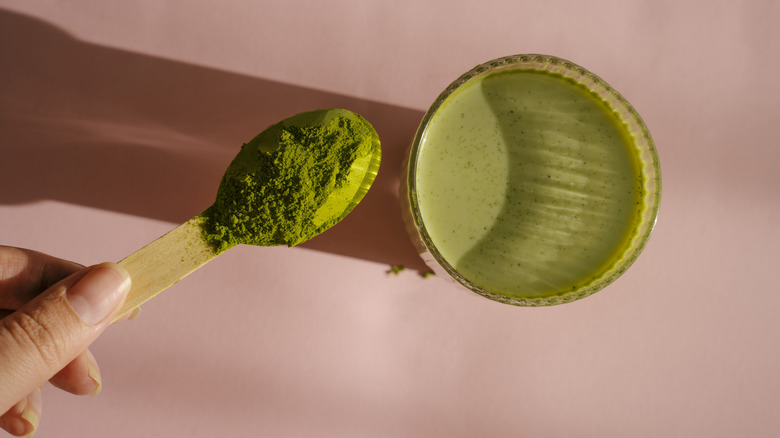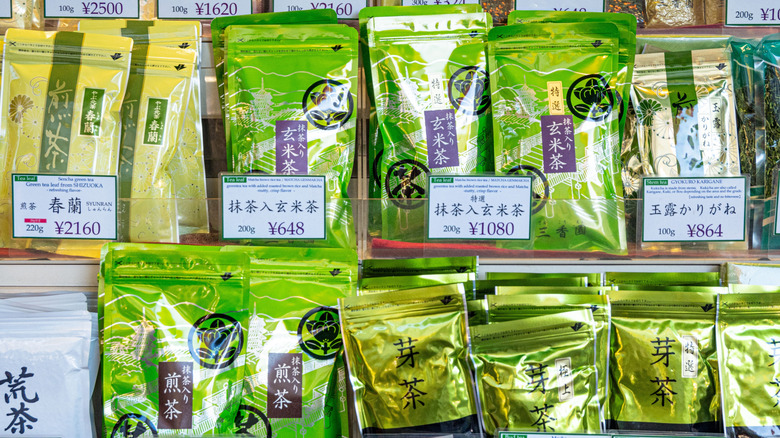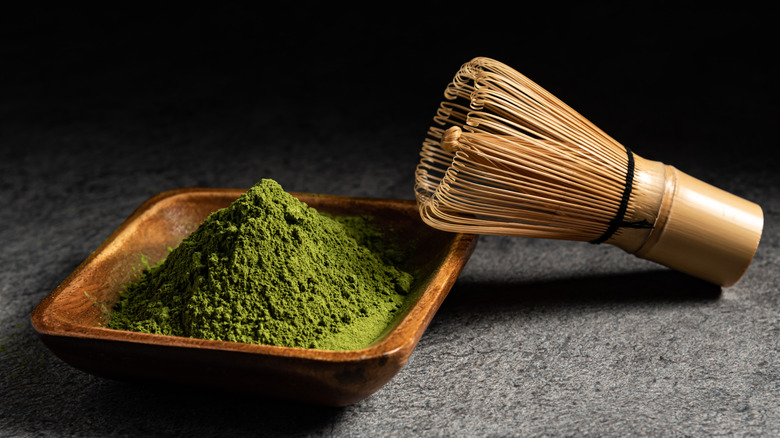Ceremonial Or Culinary? How To Pick The Right Matcha Every Time
Although matcha's origins in Japan trace back to the 12th century, the rest of the world is finally catching on to the unique aromatic tea. From Starbucks introducing unsweetened matcha to their menus, to matcha-focused specialty shops expanding in the United States, consumers are finding new ways to engage with the invigorating beverage.
It's a fascinating drink that involves very particular growth and harvesting that sets it apart from green tea. Plants are shaded during growth, picked young, then steamed and pulverized. Such a process thereby imparts a distinct vibrant green color and aromatic flavor. Its complexity translates to a large variation in the resulting matcha. Like coffee and wine, the tea transmits terroir, with the climate, soil, and handling of particular regions inspiring specific flavors. Factors like the age of harvested leaves, the grinding style, and other producer decisions also impact the resulting taste and quality.
Consequently, matcha marketers abroad have attached grades to the powdered product, most frequently delineating it into a more coveted ceremonial and cheaper culinary grade. The former is associated with a delicate, pleasurable taste that's delicious standalone. Meanwhile, the more bitter notes of the latter culinary grade are intended for combination with other ingredients. The entire process is actually unregulated, and such a style of categorization doesn't even exist in Japan. So if you're deciding between ceremonial and culinary grade matcha, take note there's no verifiable differentiation; it's only a widely applied industry label. Instead, you'll need to consider more specific qualities of each tea batch.
What is ceremonial matcha?
Intriguingly, matcha drinkers in Japan don't evaluate it with any grading system. The approach is more akin to coffee — every matcha offers a unique palate that suits a certain application. Consequently, matcha sellers created the ceremonial and culinary distinction, offering a straightforward way to sort products. Yet anyone can apply either label to their matcha — necessitating more scrupulous examination. Instead, enthusiasts seek out matcha from specific producers in certain regions, appreciating the nuanced characteristics. Like revered wine areas, common favorites include Uji, where the matcha ceremony first emerged, or Fukuoka, which is known for producing bolder-tasting tea.
Furthermore, matcha is categorized based on its intended preparation. For instance, there's the usucha technique, which entails whisking the matcha with more water dilution, as opposed to much more concentrated koicha, which creates a thick, concentrated slurry. In Japan, matcha is sold for each intended method. Older trees that produce complex flavors are dedicated to intensified koicha, often making such matcha more expensive. Nevertheless, both can be marketed under the ceremonial label, and come at varying price points. There's also matcha in Japan designated for more casual uses like flavored drinks or baking, although it won't bear a unifying culinary moniker.
Selecting intricately flavored matcha is trickier — here, the applied grade loses meaning. Rather than looking for a ceremonial tag, seek out a producer with the most comprehensive packaging. The more transparency the better — it's a sign of the tea's high quality. The tea's complex array of options is difficult to navigate, especially for those far removed from sourcing.
What is culinary matcha?
With matcha's extensive range of flavors, it's first necessary to consider your application. If you intend to mix the tea into desserts alongside bold flavors, like in a cake, donut, or even a matcha pistachio popsicle, then the palate isn't as relevant. Teas sold under any name will do; so you might as well buy affordable matcha labeled culinary grade. Typically, this tea is a less coveted harvest, exposed to more sun, and processed more crudely, resulting in bitter and astringent flavors. Nevertheless, combined with sugar and other strong flavors, its palate still suits.
Whether you're looking for culinary or ceremonial matcha, look for an origin from a well-regarded region, the cultivar variety, and verify the matcha's harvest type and date. If possible, also examine the matcha's appearance. The tea should be bright or deep green rather than brown, and have a finely ground uniform texture: a characteristic especially crucial for mixing with water or into a strawberry matcha latte.
Additionally, detailed tasting notes are a good sign; they'll help you tailor the matcha per application. You might like buttery and rich notes for whisking with water, while a more savory matcha makes for a complex-flavored batch of cookies. If the matcha is grassy or sweet it can be a delicious flavor alongside milk. So to best find your matcha, try as many teas as possible, noting preferred cultivars, origins, and brands.


